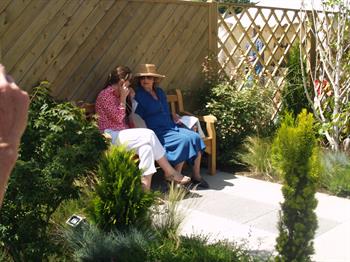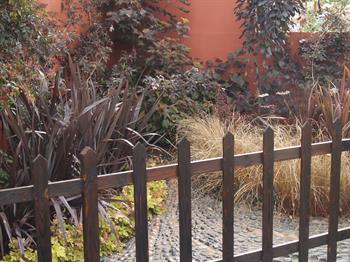Fencing
We need fences for a whole range of reasons - from keeping the dog in, to keeping burglars out.
Different fences for different purposes
The most basic function of a fence is to define the boundaries of a property, but there are many other reasons why fences are important elements of the garden:
Privacy – to stop people looking in
- Home security – from burglars, wandering animals and unwelcome visitors
- Restraining children – for small children use a high fence that cannot easily be climbed
- Restraining pets
- Screening views
- Pool safety – check your council regulations
- Windbreak/environmental control
- Reduce rubbish (eg. papers) and pollutants (eg drift of traffic fumes)

SOLID FENCE
Advantages:
- Visual screen
- Balls, pets, or other things can’t pass through
- Wind protection
- Stone or brick walls are a permanent and durable feature
- Good noise barrier
- Good for keeping toddlers in
Disadvantages:
- Hides the view
- Can be difficult to grow plants on
- Easily vandalised with graffiti
- Poor ventilation
- Can cast heavy shade
OPEN FENCE
Advantages:
- Extends the view
- Difficult to vandalise with graffiti
- Allow air movement and light
- Less expensive than solid brick or stone walls
Disadvantages:
- Lack of privacy
- Can be difficult to contain children and pets
- Open fences are usually made from timber and are therefore less durable than solid brick or stone walls

MATERIALS
Many different types of materials can be used to make a fence. Here are the most common options.
TIMBER
Timber is the most common material for fencing Australian gardens. It is easy to work and comparatively cheap. It can be fashioned into a variety of different designs. It can be solid or open and cut to different and even variable heights. Timber fences can be erected relatively quickly, sometimes in a day for small areas. If fencing material has not been treated with a suitable preservative for the prevention of rot, then make sure that it is before submerging posts into the ground and erecting the fence. You should still treat the fence with preservative even if you intend to paint it. Staining will also increase the life of the fence and is easier to touch up than paint in subsequent years.
Types of timber fence:
Panels
This is the quickest type to install and consists of ready-made panels set between posts. The disadvantage here is that an exact number of panels may not fit the dimensions of the area you wish to fence off. In this case, you either have to cut a panel (which is difficult and can spoil the aesthetics of the fence), or you have to increase or decrease the size of the area to be fenced (which is not always possible where you have neighbours involved).
Slats
These fences are stronger than panel fences. They consist of upright posts that are attached by cross-rails. Vertical slats are then secured to the cross-rails. These slats are normally wedge-shaped so that they overlap.
Pickets
Picket fences are constructed in a similar fashion to slat fences, though gaps are included between each vertical slat. This makes the fence less prone to rot as there is plenty of air circulation around the panels.
HURDLES
Hurdles make an attractive fence. They normally consist of panels constructed out of whicker, which could be made from a number of different types of timber including wattle and willow. A such they are not solid but have plenty of tiny gaps. They are not very durable and are best suited to areas where you are trying to establish a hedge or where you wish the hurdles to be subsumed by climbers.
When ‘sinking’ wooden posts into the ground, never hit the top of the post directly with your sledge hammer. Always place an off-cut of timber between the hammer and the end of the post.
Also, do not cut the post to size until it is ‘sunk’ to its final depth.
STONE
Stone fences are very hard-wearing, and if constructed properly, very durable. They look attractive whether made without mortar (dry stone walls) or cemented together. All sorts of stone is suitable for fencing including granite, sandstone and basalt and be smooth or rough-hewn. Putting up a stone fence is a major undertaking, and they are one of the more expensive types of fences to build.
BRICK
Brick is a similar material to stone. It provides a comparatively smooth, neat finish, and can be blended in with surrounding buildings made from the same material. To improve stability, larger fences are usually made with two layers of brick. Brick can also be rendered to create a smooth or rough finish that can be painted any colour.
Large stone and brick fences need solid foundations to ensure that they don’t fall down.
COPING/CAPPING
Stone and brick fences, need some sort of cover to protect them from water damage. This can be used to enhance the appearance of the fence. Copings are made of metal, cement and other waterproof materials.
Wooden fences need to have cappings on the post tops and rails along the top of fencing panels. They have bevelled edges to prevent water from sitting on them.
WIRE
Wire fences made with timber posts are widely used on farms, but can also be suitable for some garden situations.
Woven wire fences, a popular fencing and garden edging material in the 19th century, are again available from fencing suppliers. Galvanised wire rolls are used to create strong, durable and decorative barriers, and are particularly suitable for fencing around period-style houses.
STEEL OR ALUMINIUM SHEETS
Galvanised steel or aluminium sheet metal fences are a cheap, easily assembled option for those wanting a solid fence. They are usually mounted on to timber posts. The sheets will not rust and so will last a long time.
SUPPORTING THE FENCE
If fences are to stay upright, they have to be supported in the ground. Stone, brick and prefabricated metal fences are usually set into a bed of concrete. Other styles of fences are supported by posts that are usually set into the ground with concrete, a mixture of soil and concrete, hardcore, or with soil. Backfilled soil and hardcore should be thoroughly compacted with a crowbar to ensure the fence posts are secure.
STAR PICKETS & WIRE MESH/STRAND
This is a cheap, easily constructed fence, and is a practical option for fencing off large areas of land. It is not very durable since the wire has to be re-tensioned regularly, as it slackens over time. Its appearance can be improved by planting close to it.
LATTICE
Wooden lattice fences are good for growing plants. They are relatively inexpensive and offer good ventilation. The disadvantages are that they are not as strong or durable as other fencing materials, so don’t expect them to have a long life expectancy.
CAST-IRON LATTICE
This is considerably more expensive than wooden lattice, though may be worth the added expense since, if it is properly maintained, it will easily outlive most people. It is normally set along the top of stone or brick.
CLEAR PERSPEX
This is an ideal material for swimming pool surrounds, offering a strong, see-through barrier. It is a good option for those who do not like the appearance of tubular steel pool fencing. It is expensive however and will not block out the sun, making it useless as a sun-screen. It can also prove difficult to clean.
VANDALISM
Graffiti is a major problem for the owners of many solid fences.
Why not plant some spiky plants in front of your fence to deter vandals. Some particularly painful choices would be: Agave americana, Cotoneaster sp., Berberis sp., Mahonia sp..
It would also seem that vandals are less likely to attack a fence that already has a mural on it
[08/01/2026 22:21:41]